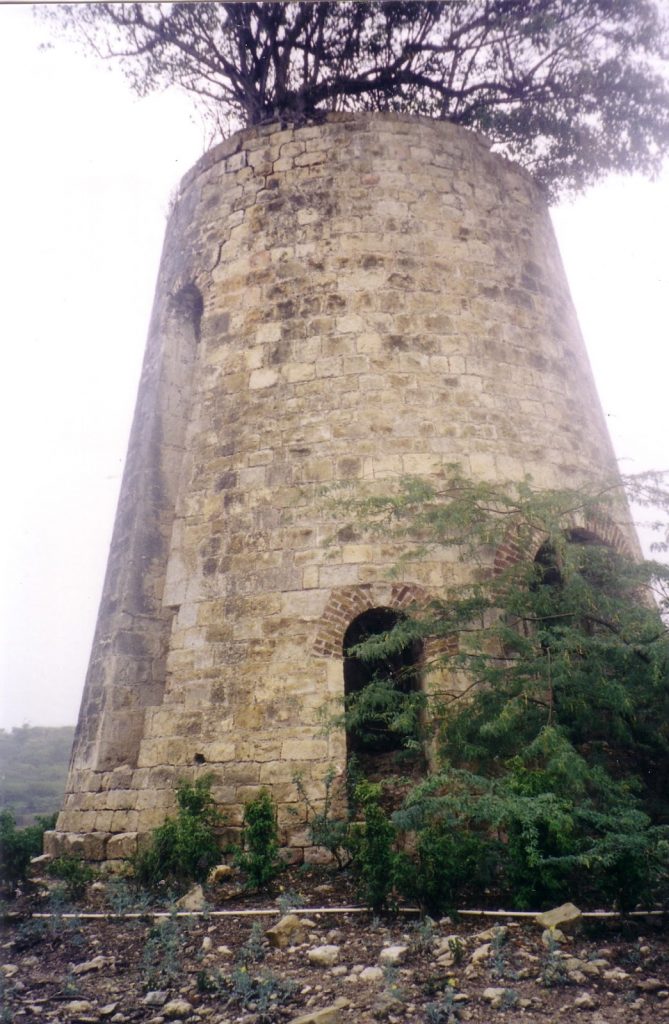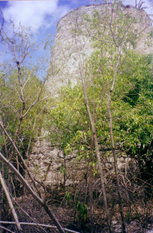About
Type: Extant
Parish: St.Philip
Founding date: 1696
See on Google Maps!

Front 
Back
Current Status
The mill is in good condition but has a large tree growing from the top which will eventually damage and erode the stone. Keystone contains inscription “T 1843” and was probably renovated after the big 1843 earthquake. Harman’s was one of nine estates purchased by the Antigua Distillery in order to produce molasses for the production of Cavalier Rum and is the site of the Harmon family cemetery.
Estate Related History/ Timeline
“Capt. William Harman RN (dec.1708) owned lands in Antigua & Barbados before 1696.”
1775: “Sarah Loyd by her will dated 1775 she entailed her estate “Harmans” on her nephew William Wickham Harman.”
1721: Maj. Charles Lloyd of Lloyds in Antigua (d.1721c.) “Could this be Lloyds of London Insurance Company?
Sarah Lloyd by her will dated 1775 she entailed her estate “Harmons (#120) on her nephew William Wickham Harman.” Vere Oliver Vol.II p.63
1721: Maj. Charles Lloyd of Lloyds in Antigua (d.1721c.)
1741: James Gordon arrived in Antigua from St. Kitts where he was chief justice of the island. He purchased Gales estate which became known as Table Hill Gordon.
1775: Sarah Lloyd by her will dated 1775 she entailed her estate “Harmons on her nephew William Wickham Harman.” Vere Oliver Vol.II p.63
There was a notation in the Cranstoun family history of a Samuel Bickerton of Harmans, Antigua, who was educated at Kings College in London, later moved to Toronto and became a lawyer and a DCL at Trinity College. In 1869 he was Mayor of Toronto and Treasurer from 1872-1878. As there is no mention of ownership, he or his family could have been managers or attorneys for the estate.
1829: contained 148 acres and 139 slaves.
1832: William Harman will 1832. “and give her (wife Mgt. Spencer) everything in the house on my estate called Montpelier.”
“In a private burial ground at `Harmon’s,’ St. Philip’s Parish, there are three vaults. The third vault contains no MI. These tombs lie enclosed by a low wall near the road leading from Montpelier to Harmon’s.” History of the Island of Antigua by Vere Oliver. Vol.II.
1851: The Antigua Almanac shows that Harmon’s of 148 acres was owned by Samuel B. Harman.
1852: “Harmans 148 acres in 1852 owned by Samuel B. Harman.”
In a field nearby is the private cemetery of the Harmon family, Samuel Harmon who died 1750 and another Samuel Harmon, dying in 1767. Ancestors of the Harmon family visited Antigua in the late 1900’s and after visiting the walled grave site donated money to have the site repaired. Nearby is Harmon’s Estate.
Graves found: Harman/A, Harman/M Harman, Mary, Harman/Samuel, Harman/Dorothy, Harman/Samuel, Harman/ St., Harman/St., Harman/…, Harman/IX, Harman/Mary Blizard, Harman/Thomas DuBerry.
There is also a Harman grave at St. Philips.
www.tombstones.bb (2005)
1944: Harman’s became part of the holdings for Antigua Distillery aligned with Montpelier Sugar Factory.
1946: The chief engineer for Montpelier was a Canadian, Charlie Lang, who lived at Harmon’s. When he left in 1947 Francis Nunes and family moved into the Harmon house prior to moving into the Montpelier buff house in 1949. It was a small house of not much note but great countryside for raising the children. Francis Nunes.
Enslaved People’s History
Based on contemporary research, we have little information to share about the enslaved peoples from this plantation at this time. We do know that Samuel Harman’s was awarded £2,038 2 s 0 d for 146 enslaved peoples’ freedoms when slavery was abolished in the Caribbean. We will continue our quest for more information about these vital individuals.
Legacies of British Slave-ownership: Samuel Harman’s was awarded £2,038 2s 0d for 146 enslaved. Awardees were J. Ahile, Albert Francis Favey, W. Graham, John Jones, John McKie, William Shand, Maj. Edmund Yeamons Walcott and George Lodowick Wilder. Beneficiary deceased was Samuel Mathew Clogstoun, beneficiary was Caroline Clogstoun (nee Walcott) and unsuccessful were Anthony Browne and Samuel Harman.
Legacies of British Slave-ownership claimants. www.ucl.ac.uk/lbs/.
In 1833 Parliament finally abolished slavery in the British Caribbean, Mauritius and the Cape. The slave trade had been abolished in 1807 but it took another 26 years to effect the emancipation of the enslaved. The legislation of 1833 was the result of a combination of factors where it was felt that the plantation owners should be compensated for their slaves who were to be freed. The amount of 20 million pounds , a huge amount in those days, was divided up between all slave owners.
J. Ahile – absentee/resident? – awardee – Antigua 270 (Samuel Harmon’s) 766 – £2,038 2s 0d (146 enslaved).
Ownership Chronology
- Ownership from 1696 Capt. William Harman (d.1708)
- Samuel Harman (1696-1760)
- Samuel Harman (1730-1767)
- 1750: Sarah Lloyd (will 1775)
- 1775: William Wickham Harman
- 1775: Samuel Harman (1764-1816) portrait exists
- 1750: Hon. Wm. Lavington (not sure)
- 1790: James Gordon. (may have leased since it remained in
- 1829: J.A. Gordon. the Harman family.)
- 1820: Samuel Harman (1789-1841)
- 1851: Samuel Bickerton Harman – 118 acres, 148 slaves 1851 Antigua Almanac.
- 1871: Frederick Berkley Harman (1825-1881: age 56 years) – 369 acres with Walrond’s
- 1872: Miss L.L. Willock – with Walrond’s 359 acres 1872 Antigua Horsford Almanac.
- 1878: F.B. Harmon – 674 acres with Upper Walronds, Montpelier & Hope
- 1891: James Maginley (1835-1895)
- 1921: J.Walter A. Maginley (d.1945)
- 1933: Ernest Dew 1933 Camacho map.
- 1944: The Antigua Distillery (Montpelier)